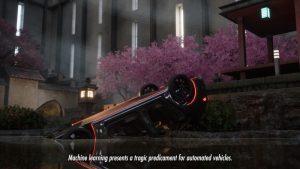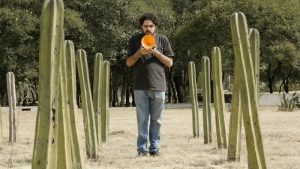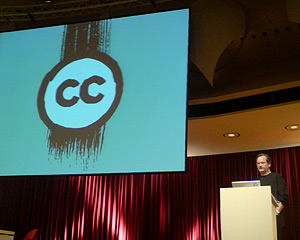 A short recap of Creative Commons-founder Lawrence Lessig‘s evangelization talk (or rather motivation session for the converted) at 23C3 in Berlin about the differences between culture and code.
A short recap of Creative Commons-founder Lawrence Lessig‘s evangelization talk (or rather motivation session for the converted) at 23C3 in Berlin about the differences between culture and code.
The fundamental change is the fact that code had been used to create things like printer-drivers and such. But – since a few years, code, or rather the tools that had been coded have become a main element in the creation of culture as we use and witness it today. Especially the whole mashup-culture is heavily relying on the techniques and the mindset of digital creation and open access to other’s works for sampling from and building upon, etc. Popular examples are the anime music-clip subculture like the Muppet Hunter, the Jesus Christ the Musical-clip or lots of pieces that borrow from news networks’ footage to make their own suggestive edits.
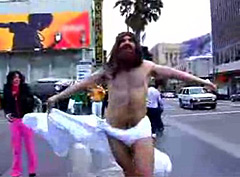 So you could regard this as the pinnacle of today’s tools of creativity, even the most important contemporary form of expression, probably even replacing speech and text in an American mass-media context as the main means to reach people. Having said this (and that’s a bit of a rhetorical trick), he argued that threatening the freedom of this kind of usage of media equals threatening the freedom of speech itself. But, and that’s a fact, the nagging question is whether this form of expression is legal or not, both in the US and elsewhere. Lessig told of a recent meeting in NYC where lawyers tried to explain the four conditions which you have to fulfil to be able to work under the law of Fair use. It took four lawyers, one hour and in the end the audience was only more confused. To him he said, it seemed a bit like the the Soviet Union somewhere in between the height of its power and its downfall and brought up the question just how you could have convinced the Soviet officials to change their system in that era.
So you could regard this as the pinnacle of today’s tools of creativity, even the most important contemporary form of expression, probably even replacing speech and text in an American mass-media context as the main means to reach people. Having said this (and that’s a bit of a rhetorical trick), he argued that threatening the freedom of this kind of usage of media equals threatening the freedom of speech itself. But, and that’s a fact, the nagging question is whether this form of expression is legal or not, both in the US and elsewhere. Lessig told of a recent meeting in NYC where lawyers tried to explain the four conditions which you have to fulfil to be able to work under the law of Fair use. It took four lawyers, one hour and in the end the audience was only more confused. To him he said, it seemed a bit like the the Soviet Union somewhere in between the height of its power and its downfall and brought up the question just how you could have convinced the Soviet officials to change their system in that era. 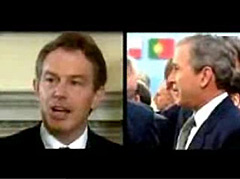 In his view, the system as it exists today doesn’t work anymore (and it’s constantly being ignored by many people because of that) and needs to be changed, so how would that work?
In his view, the system as it exists today doesn’t work anymore (and it’s constantly being ignored by many people because of that) and needs to be changed, so how would that work?
Firstly, what won’t work – Hackers and technologists trying to break the system: They will continue to be able to break manifestations of the system like DRM but that is not really solving the overall problem. (John Perry Barlow later strongly disagreed and argued that “a combination of massive civil disobedience and the fact that we [the electronic Hezbollah] are more skilled” will solve all those issues). Count on the system to change itself: Won’t work either, especially in the US-context where virtually all parts of the political spectrum are strongly opposed against changing intellectual property rights towards greater openness. A guy he called Hollywood Howard just got to be the head of the most powerful organization in that area, proving that the property lobby has established a very firm grip there. Litigation: Lessig is a lawyer, and he first tried to go the legal way, took the case about Sunny Bono to the supreme court – and lost. In his view, the courts don’t understand the issue.
Secondly, what will work – creating an infrastructure. In the late 1930s there was an interesting process in the US where an organization called ASCAP was owning all the rights to the most popular music and thus virtually holding the emerging broadcasting industry practically hostage. A second organization, called BMI, appeared, and even though they had an inferior portfolio of artists and titles, quickly shattered the power of ASCAP because they offered a far more attractive infrastructure for both artists and broadcasters. In Lessig’s view, Creative Commons’ ideal role would be to empower the change to come through the same creation of a framework.
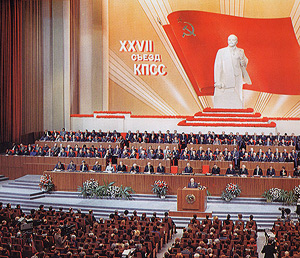 However, despite the amazing success of CC with 150 million licenses already issued, there are people who disagree, also within the free code/culture/knowledge-movement. There (and this was also a nifty rhetorical trick), he revealed that actually, he’s one of the old Soviets himself, because he actually doesn’t want copyright as such to be abolished. While the we-don’t-care-about-copies or join-if-you-want-to-use attitudes of the Copyleft and GNU movements may be right for some types of creativity, mainly the creation, improvement and distribution of computer software, it may not work for others. There are some forms of artistic expression like photography where a rule that only gets triggered when users actually creatively alter the creation doesn’t help much – if you put a photo up on Flickr under one of those licenses, Fox News could use it freely for evil misinformation if they do not change the photo itself.
However, despite the amazing success of CC with 150 million licenses already issued, there are people who disagree, also within the free code/culture/knowledge-movement. There (and this was also a nifty rhetorical trick), he revealed that actually, he’s one of the old Soviets himself, because he actually doesn’t want copyright as such to be abolished. While the we-don’t-care-about-copies or join-if-you-want-to-use attitudes of the Copyleft and GNU movements may be right for some types of creativity, mainly the creation, improvement and distribution of computer software, it may not work for others. There are some forms of artistic expression like photography where a rule that only gets triggered when users actually creatively alter the creation doesn’t help much – if you put a photo up on Flickr under one of those licenses, Fox News could use it freely for evil misinformation if they do not change the photo itself.
This is, why CC is designed to be a modification to copyright which allows creators to assign licenses to their work in a more flexible way instead of imposing an quasi-ideological demand to share all their work for free on them, often met by great criticism. Lessig does admit however, that creative domains other than the creation of code will need to fight the same struggles as the free software-community has done in the last three decades in order to win this war. (Yes, he really said war) Closing the session, amidst an even more heated discussion, he pointed out that the current situation reminds him a lot of the movie Awakenings where a group of people who had been in a condition called catatonic state wake up and stay awake for a limited time before they fall back into this state. To Lessig, we’re now in this phase of wake and we have a certain timeframe before the people who oppose access to culture will have cemented their views through DRM and legal deadlocks. Barlow had still a mic and replied “Oh, you’re such a pessimist”.
You can find some more pictures on the 23C3-pool on Flickr and an actual gnu was also spotted at the venue.
UPDATE: Here’s the complete talk on Google Video. (Via Joi Ito)



